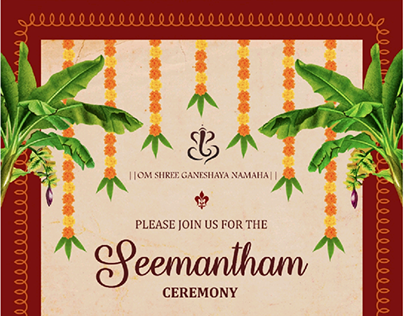Seemantham, also known as Seemantha or Simant, is a traditional Hindu ceremony performed during the seventh month of pregnancy. It is a joyous occasion celebrated to bless the mother-to-be and her unborn child, ensuring a safe and healthy delivery. Finding the perfect Seemantham invitation in English can be both exciting and challenging. This article will guide you through the process, providing tips, templates, and ideas to create the ideal invitation for this special event.
Understanding Seemantham
What is Seemantham?
Seemantham is a prenatal ceremony performed by Hindu families, primarily in South India. It is akin to a baby shower in Western cultures, where the focus is on the well-being of the mother and the unborn child. The ceremony typically involves various rituals, including the application of sacred substances to the mother’s hair and prayers for a safe childbirth.
Significance of Seemantham
The Seemantham ceremony holds immense cultural and religious significance. It is believed to protect the mother and child from evil spirits, ensure a smooth delivery, and bless the child with a prosperous future. It is also a time for the family to come together and celebrate the impending arrival of a new family member.
Importance of a Seemantham Invitation
Role of Invitations in Seemantham
Invitations play a crucial role in any ceremony, and Seemantham is no exception. They serve as the first point of contact with guests, setting the tone for the event. A well-crafted Seemantham invitation in English can convey the cultural richness and significance of the ceremony while being accessible to a wider audience.
Traditional vs. Modern Invitations
Traditionally, Seemantham invitations are ornate, featuring intricate designs and Sanskrit verses. However, modern invitations often blend traditional elements with contemporary aesthetics. This fusion appeals to the sensibilities of today’s families, who may prefer a more minimalist or theme-based design.
Components of a Seemantham Invitation
Key Elements
A Seemantham invitation typically includes the following elements:
- Event Name: Clearly state that the invitation is for a Seemantham ceremony.
- Names: Include the names of the parents-to-be and the hosting family.
- Date and Time: Provide the exact date and time of the ceremony.
- Venue: Mention the location of the event with complete address details.
- RSVP Details: Provide contact information for guests to confirm their attendance.
Wording and Phrases
The wording of the invitation should reflect the joyous and sacred nature of the event. Here’s an example of how you can phrase it:
“Join us in celebrating the Seemantham of [Mother’s Name], where we gather to bless her and her unborn child. Your presence will bring joy and blessings to this auspicious occasion.”
Choosing the Right Design
Traditional Designs
Traditional Seemantham invitations often feature motifs such as peacocks, lotus flowers, and other symbols of fertility and prosperity. They may also include religious imagery like deities and sacred texts. The color palette typically includes rich hues like gold, red, and green.
Modern Designs
Modern invitations may use simpler designs with clean lines and minimalistic elements. They often incorporate contemporary fonts and pastel colors, making them visually appealing to a broad audience. Digital illustrations and abstract patterns are also popular in modern designs.
Customizing Your Invitation
Personal Touches
Adding personal touches to your Seemantham invitation can make it more memorable. Consider including a photo of the parents-to-be or a family crest. You could also add a personal message or a favorite quote that resonates with the occasion.
Cultural Elements
Incorporating cultural elements into your invitation design can enhance its authenticity. This could include traditional symbols, patterns, and colors that reflect your heritage. For instance, you might use motifs specific to your region or community.
Invitation Templates
Basic Template
Here’s a basic template for a Seemantham invitation in English:
[Event Name: Seemantham Ceremony]
You are cordially invited to the Seemantham of
[Mother’s Name]
Date: [Day, Month, Year]
Time: [Start Time] to [End Time]
Venue: [Complete Address]
RSVP: [Contact Information]
Detailed Template
For a more detailed invitation, you can include additional information and decorative elements:
With great joy and happiness, we invite you to the Seemantham of
[Mother’s Name]
Date: [Day, Month, Year]
Time: [Start Time] to [End Time]
Venue: [Complete Address]
Join us as we come together to bless [Mother’s Name] and her unborn child for a safe and healthy delivery.
RSVP: [Contact Information]
Hosted by: [Host Names]
Digital Invitations
Advantages of Digital Invitations
Digital invitations have become increasingly popular due to their convenience and eco-friendliness. They can be easily shared via email, social media, or messaging apps, ensuring that your invitation reaches guests promptly.
How to Create Digital Invitations
Creating digital invitations is simple and can be done using various online tools and apps. Websites like Canva, Evite, and Paperless Post offer customizable templates specifically designed for Seemantham and other cultural ceremonies. You can choose a template, personalize it with your details, and share it online.
Printing Your Invitations
Choosing the Right Paper
If you prefer physical invitations, selecting the right paper is crucial. High-quality paper can make your invitation look and feel more elegant. Options like cardstock, textured paper, and handmade paper are popular choices for Seemantham invitations.
Printing Options
You can print your invitations at home if you have a good-quality printer or use professional printing services. Many print shops offer customization options, including embossing, foiling, and laser cutting, to enhance the look of your invitations.
Distribution of Invitations
Sending Physical Invitations
When sending physical invitations, ensure they are mailed well in advance to give guests ample time to RSVP. Include a return envelope or contact information for guests to confirm their attendance.
Using Digital Platforms
Digital platforms offer a quick and efficient way to distribute your invitations. You can create an event on social media, send invitations via email, or use messaging apps to share your digital invite. Ensure you follow up with guests to confirm their attendance.
Seemantham Invitation Etiquette
Dos and Don’ts
- Do personalize your invitations to reflect the significance of the event.
- Don’t forget to proofread your invitation for any errors before sending it out.
- Do include all essential details such as date, time, venue, and RSVP information.
- Don’t wait until the last minute to send out your invitations.
Common Mistakes to Avoid
- Missing key information: Ensure all details are clearly mentioned.
- Overcrowding the design: Keep it simple and elegant.
- Late distribution: Send invitations well in advance.
Conclusion
Creating the perfect Seemantham invitation in English involves a blend of tradition and modernity. By understanding the significance of the ceremony and incorporating key elements, you can craft an invitation that resonates with your guests and reflects the joy and blessings of this special occasion. Whether you choose a traditional design or a modern digital invitation, the most important aspect is to convey the warmth and significance of the Seemantham ceremony.
FAQs
Q: What is the best time to send out Seemantham invitations? A: It is best to send out invitations 3-4 weeks before the ceremony to give guests ample time to RSVP.
Q: Can I create a Seemantham invitation in English even if the ceremony is traditional? A: Yes, you can create an invitation in English to ensure it is accessible to all guests while maintaining the traditional essence through design and wording.
Q: Are digital invitations appropriate for Seemantham? A: Absolutely, digital invitations are convenient, eco-friendly, and can be beautifully designed to suit the occasion.
Q: How can I make my Seemantham invitation unique? A: Personalize your invitation with photos, a heartfelt message, and cultural motifs that reflect your heritage.
Q: What should I include in a Seemantham invitation? A: Ensure you include the event name, names of the parents-to-be, date and time, venue, RSVP details, and a brief message about the significance of the ceremony.
















